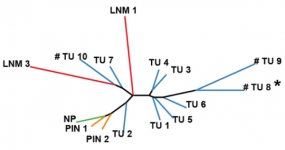One cancer – many tumors
In studies on prostate cancer, scientists from the German Cancer Research Center (DKFZ) simultaneously investigated the genetic and epigenetic development of the tumors. They used a parallel approach to analyze both the genome and the methylation of the DNA in various tissue samples from a tumor and its metastases. Both processes equally reflect the complex composition of multiple different daughter clones in advanced tumors. As DNA methylation impacts the activity of genes, detecting diverging methylation patterns may help understand the origins of metastases and choose more specific treatment strategies.

A diagram illustrating the epigenetic evolution of a tumor: green: normal tissue; orange: premalignant tissue; blue: primary tumor; red: lymph node metastasis
© Nina Cabezas/DKFZ
Advanced tumors are characterized by a multiplicity of defects in their genome. In many cancers, thousands of small “typos” in the genetic material lead to transformed, dysfunctional proteins. Prostate cancer, however, typically exhibits larger genomic defects where whole segments of DNA are lost, duplicated or arranged in the wrong order. In addition to these structural defects, tumors of the prostate are also characterized by huge differences in the patterns of DNA methylation. The cell uses these small chemical tags, which are a type of epigenetic mechanism, to regulate various processes including the activity of particular genes.
As cancer progresses, structural alterations in the genome accumulate and lead to an “evolution” of the cancer cells. As a result, an advanced tumor is composed of a group of various “daughter clones”. This means not only that each tumor of the prostate is unique but also that each individual tumor is composed of different clones that may differ in clinical aspects such as resistance to treatment.
Scientists in the group of Christoph Plass at the German Cancer Research Center (Deutsches Krebsforschungszentrum, DKFZ) and collaborators in the German ICGC Consortium “Early onset prostate cancer” have now studied whether the epigenetic changes in a tumor can also be used to trace its evolution and hence the composition of its various daughter clones. In five cases of prostate cancer they simultaneously analyzed the genes and their methylation.
The researchers compared tissue samples taken from different parts of a tumor with surrounding tissue that was not yet completely transformed as well as with metastases in the lymph nodes. They showed that both the structural genomic alterations and the changes in the methylation patterns equally reflected the evolution of the individual tumors. It seems that the evolution of the epigenome progresses in a process parallel to the appearance of new structural genomic changes.
An important observation is that metastases not necessarily form at the “end” of a tumor’s development. In one case, for example, the metastases lacked the chromosome abnormalities that characterized all other tissue samples from this tumor, suggesting that the daughter tumors had developed early on. In some of the cases under investigation, the metastases arose from a common progenitor, while in others they originated from different daughter clones. It generally holds true that metastases always exhibit characteristics that are not found in the other daughter clones. As a rule, these epigenetic or genetic changes affect genes that lend metastasizing cancer cells their typical properties.
The epigenetic differences among the daughter clones are not distributed evenly across the whole tumor genome. In most cases, they particularly affect areas that are relevant for prostate-specific processes. These include, for example, the “gene enhancers” that are regulated by the receptors for the male sex hormone androgen. Since the various methylation patterns have an impact on gene activity, it is to be expected that the daughter clones exhibit big differences in the way they process androgen signals.
“The genetic and epigenetic evolution processes of prostate tumors are independent of each other but they lead to the same end,” Dr. Clarissa Gerhäuser explains. “Therefore, the technologically less complex detection of the epigenetic evolution of individual daughter clones may serve to rapidly and precisely obtain functional information that is relevant for clinical decisions.” The scientists think that a better understanding of the genetic and epigenetic variety within a tumor may help improve treatment outcomes.
David Brocks, Yassen Assenov, Sarah Minner, Olga Bogatyrova, Ronald Simon, Christina Koop, Christopher Oakes, Manuela Zucknick, Daniel Bernhard Lipka, Joachim Weischenfeldt, Lars Feuerbach, Richard Cowper-Sallari, Mathieu Lupien, Benedikt Brors, Jan Korbel, Thorsten Schlomm, Amos Tanay, Guido Sauter, Clarissa Gerhäuser and Christoph Plass: Epigenetic Intratumor Heterogeneity reflects Clonal Evolution in Aggressive Prostate Cancer. Cell Reports 2014, DOI: 10.1016/j.celrep.2014.06.053
With more than 3,000 employees, the German Cancer Research Center (Deutsches Krebsforschungszentrum, DKFZ) is Germany’s largest biomedical research institute. DKFZ scientists identify cancer risk factors, investigate how cancer progresses and develop new cancer prevention strategies. They are also developing new methods to diagnose tumors more precisely and treat cancer patients more successfully. The DKFZ's Cancer Information Service (KID) provides patients, interested citizens and experts with individual answers to questions relating to cancer.
To transfer promising approaches from cancer research to the clinic and thus improve the prognosis of cancer patients, the DKFZ cooperates with excellent research institutions and university hospitals throughout Germany:
The DKFZ is 90 percent financed by the Federal Ministry of Education and Research and 10 percent by the state of Baden-Württemberg. The DKFZ is a member of the Helmholtz Association of German Research Centers.

